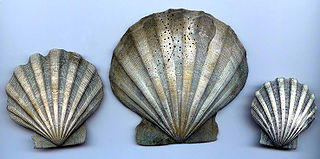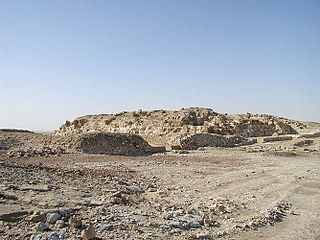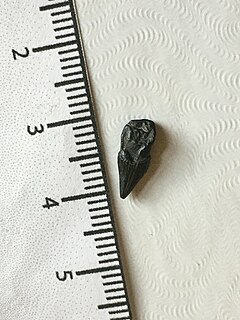
Chesapecten is an extinct genus of scallop known from marine strata from the early Miocene to the early Pleistocene of the Eastern United States.

Abu Rawash, 8 kilometres (5.0 mi) north of Giza, is the site of Egypt's most northerly pyramid, also known as the lost pyramid – the mostly ruined Pyramid of Djedefre, the son and successor of Khufu. Originally, it was thought that this pyramid had never been completed, but the current archaeological consensus is that not only was it completed, but that it was built about the same size as the Pyramid of Menkaure – the third largest of the Giza pyramids. One notable fact about the pyramid at Abu Rawash is that the upper most part of the pyramid has seemingly disappeared, revealing the internal passage that runs down into the bedrock. Explanations to why this pyramid is missing its top vary. The second point of interest that this pyramid provides is that it is built on top of a hillock. The builders faced the colossal task of not only hauling megalith stones up a pyramid but also up a hillock.

Macrogastra plicatula is a species of air-breathing land snail, a terrestrial pulmonate gastropod mollusk in the family Clausiliidae, the door snails.

The Plicatulidae are a family of saltwater clams, marine bivalve mollusks, known commonly as kitten's paws or kittenpaws. These bivalves are related to oysters and scallops. The family has a single living genus, Plicatula, with a second, Harpax known from fossils.
The clausilium is a calcareous anatomical structure which is found in one group of air-breathing land snails: terrestrial pulmonate gastropod mollusks in the family Clausiliidae, the door snails. The clausilium is one part of the clausilial apparatus.
The Argiles à Plicatules is a geological formation in northern central France whose strata date back to the Early Cretaceous. Dinosaur remains are among the fossils that have been recovered from the formation.

The Budden Canyon Formation is the name of a sedimentary rock formation in California of Cretaceous (Berriasian-Turonian) age.

The Jagua Formation is a Late Jurassic geologic formation in the Sierra de los Órganos and Sierra del Rosario mountain ranges in Pinar del Río Province, western Cuba. Plesiosaur, pliosaur, pterosaur, metriorhynchid, turtle and dinosaur remains are among the fossils that have been recovered from its strata.
Pareuthria plicatula is a species of sea snail, a marine gastropod mollusk in the family Buccinidae, the true whelks.
Lucidella plicatula is a species of land snail with an operculum, terrestrial gastropod mollusk in the family Helicinidae.

Plicatula gibbosa, or the Atlantic kitten's paw, is a species of bivalve mollusc in the family Plicatulidae. It can be found along the Atlantic coast of North America, ranging from North Carolina to the West Indies.

The Old Church Formation is a geologic formation in Virginia and possibly Maryland. It preserves fossils dating back to the Oligocene epoch of the Neogene period. It rarely exposes on land and is under-studied. However, deposits from this period are rare and the Old Church Formation likely contains many scientifically significant taxa. Ward (1985) recommended placing this formation in the Chesapeake Group.
The Piney Point Formation is a geologic formation in Virginia. It preserves fossils dating back to the Lutetian Stage of the Eocene Epoch of the Paleogene period.

The Muleros Formation is a geologic formation in New Mexico. It preserves fossils dating back to the early Cretaceous period.

The Carbonera Formation is a geologic formation in Mexico. It preserves fossils dating back to the Berriasian to Hauterivian stages of the Early Cretaceous period.

Naticopsis is an extinct genus of small sea snails belonging to the family Neritopsidae.

Lorabela plicatula is a species of sea snail, a marine gastropod mollusk in the family Mangeliidae.
Octotoma plicatula, the trumpet creeper leaf miner, is a species of leaf beetle in the family Chrysomelidae. It is found in North America.
Amyema plicatula is a species of hemi-parasitic shrub found in the Bismarck Archipelago, New Guinea, New South Wales and Queensland.










